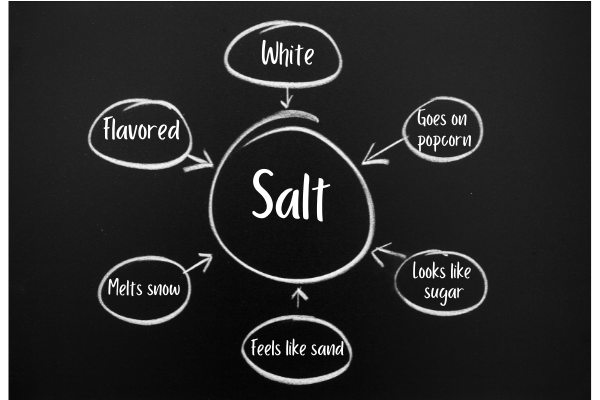We had our first snow storm of the season a few weeks ago, and the maintenance crew had sprinkled rock salt on the sidewalks to help prevent falls. As I was bringing children into the school from the drop-off lane, I got question after question about what the tiny pieces of ice on the ground were. I explained over and over again that it was salt to help the snow and ice melt in the places we needed to walk.

Later, during class, a couple of children found pieces of this salt that had hitched rides on small pairs of shoes and made its way to the classroom carpet. Again, more questions about what it was and why it was there. On the way out at the end of the day…you guessed it. More questions.
I mentioned to the director that this would be a perfect opportunity to do some fun, hands-on learning about something the kids had a genuine curiosity about. At its most simple, we could freeze some water, sprinkle rock salt on it, and watch what happens over the course of our day. But, we could also take a project-based learning approach and dive deep to learn about where salt comes from and what kinds of things it is used for. We could touch, taste, and smell it. We could hypothesize and conduct various scientific experiments using salt. We could incorporate it into our art and sensory centers. We could break out the microscope and look at it up close and in detail. The possibilities go on and on.
Taking a project approach to teaching in early childhood classrooms comes with many benefits. Because its foundation is in children’s natural curiosity, the learning is very engaging, and the take-aways can be deep and powerful.
Let’s take a look at what engaging in a project in a preschool classroom might look like. Generally, it is easiest to take on a project in 3 stages. Each stage can last as long as it needs to–a simple project might last a few days, while a more complex project might last several weeks.
Stage 1

A new project begins when a topic of interest is identified. With my recent example, the topic of salt formed organically as the children noticed something they were unfamiliar with and expressed an interest in knowing more. During this stage, I would engage the children in a discussion to find out what they already knew. Asking questions and making lists would help build the basis for what we wanted to study further.
Stage 2

Information-gathering and research are the two main goals of this stage. This is where the children explore, hypothesize, experiment, and engage with the topic at hand. Introduce aspects of your topic into sensory, art, and writing centers. Bring in experts from the community. Ransack the library for books related to the topic. Pay special attention to how the students are steering the project…you may have anticipated it would go in one direction, but their interests take it in a completely different direction. Collect work samples and take pictures throughout the entire process.
Stage 3

Every good project eventually comes to an end. In stage 3, we reflect on our learning. We might revisit the list we made in stage one to see how far we had come–what we knew then vs. what we know now. We can look back at our pictures and work samples to see the conclusions we came to during our research. Children love seeing pictures from their project and remembering when specific discoveries were made! Reflection is an important part of the process because it helps children make the connection between active learning and knowledge acquisition.
Benefits to project-based learning
- Children love learning about topics they choose themselves. It’s not hard to garner participation when the kids are excited about the subject matter.
- It provides an opportunity for children to develop a rich vocabulary in a specific area of interest.
- Communication & Cooperation–learning to share ideas, consider the ideas of others, and work together to make those ideas come to life.
- Children learn how to use a broad range of strategies to explore in detail. They learn how writing, art, science, and math can all work together to give them information about the same topic.
- Depth of study is very flexible–children can choose to focus on one specific aspect of a topic and really dive deep, or gain general knowledge across a broad range of the topic.
Challenges to project-based learning
- Project-based learning requires a plan-as-you-go approach. You can’t write a month’s worth of lesson plans at a time. Each day presents you with the information you need to gather whatever materials will allow the learning to continue the next day, and because this is a child-led approach, there is not quite as much flexibility to plan far in advance.
- Interest may fizzle. Not every project is a rousing success, and that’s ok. If interest wanes and the children express a desire to move onto something different, roll with it. Wrap up the reflection stage and switch gears.
- Interest may last forever. This is really only a challenge because the adults in the room may get tired of talking about salt week after week after week. The rewards of seeing the children drive their project and gain so much knowledge trumps any boredom us grownups might have with the topic 😉
If you’ve never tried project-based learning, I’d encourage you to see how it goes in your classroom. You’ll be amazed at how much learning takes place when you put your students behind the wheel and let them do the driving. Taking a supporting role and doing more observing than direct teaching will help build your skills as an educator as well!